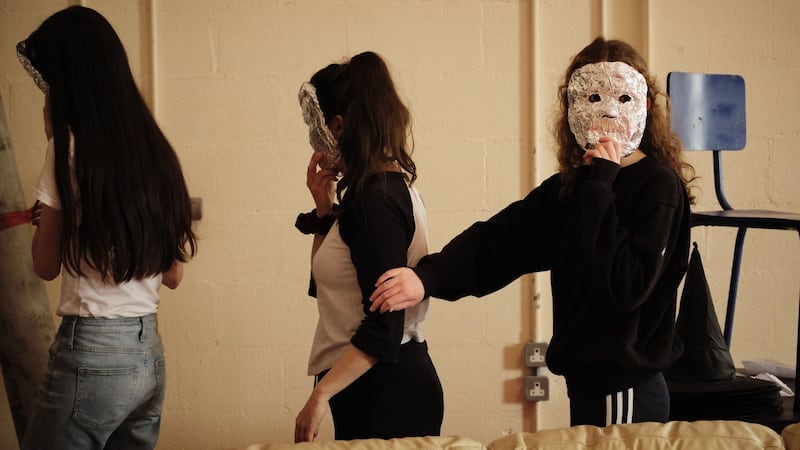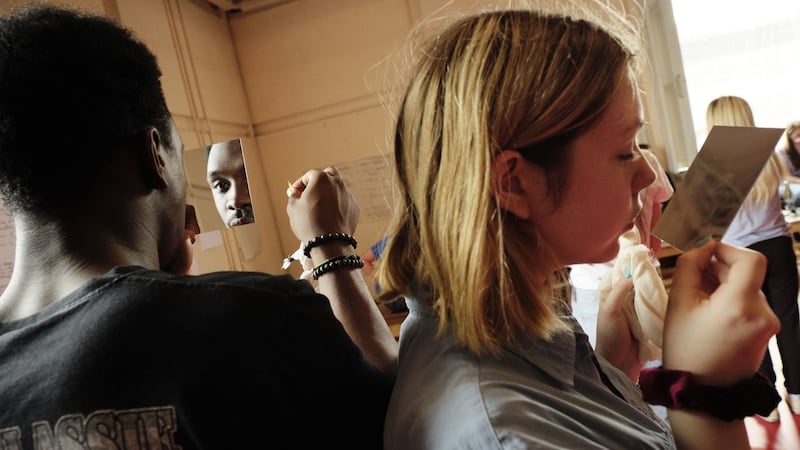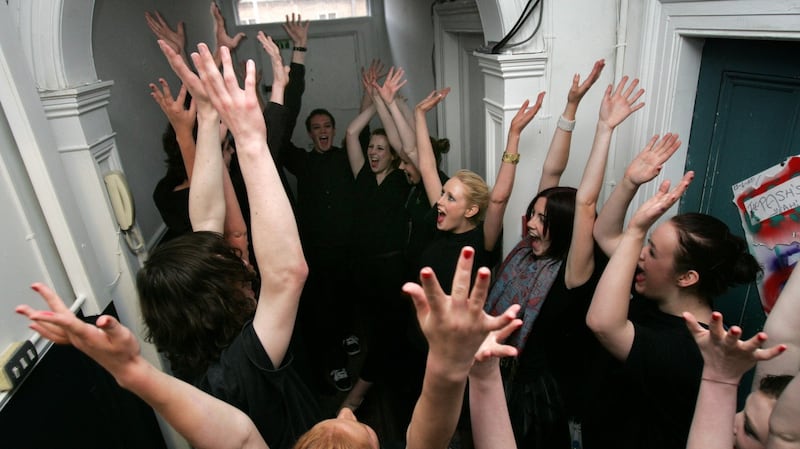Two months ago, Dublin Youth Theatre (DYT) did something that many of its members find increasingly difficult to imagine themselves. It left home.
Long expected, but poignant nonetheless, the move represents the end of a long era. Since 1978, DYT’s home has been a three-story red-brick terrace on 23 Upper Gardiner Street; a pleasingly ramshackle Georgian building that contained its offices, living-room rehearsal spaces, a jerry-rigged theatre painted black, and a caretaker’s apartment. To successive generations at DYT it was known simply as “The House”.
Sold earlier this year, the premises had not quite kept pace with the needs of its members. "We've just kind of outgrown this building," Sarah Bragg-Bolger, DYT's general manager, put it diplomatically in a video recorded last year. Alan King, an alumnus and long-time associate, was more blunt. "It's falling down," he said.
While the organisation is searching for a new space, a small representation of its members have found a temporary base in Trinity College Dublin, in the bright dance studio of the School of Drama. There, on a sunny day a couple of weeks ago, 17 cast members were rehearsing what is known to DYT as "the Big Show", a devised work for public performance.
To attend rehearsals of The Sleepwalkers, which is partly inspired by the loss of the DYT premises, you have to ascend through spaces that are resonant with the history of the Big Show's professional collaborators, Pan Pan Theatre Company.


There is the department where its founders and co-artistic directors, Gavin Quinn and Aedín Cosgrove, first found their instincts for experimental theatre. There are the venues where they presented some of their most influential works and ground-breaking festivals.
Is Gavin Quinn, director of The Sleepwalkers, given to nostalgia? “That’s a good question,” he says. “I would say I am not nostalgic, but I also don’t think that things have to change all the time.”
Somewhere between sentimental and experimental, DYT and Pan Pan are meeting each other halfway for The Sleepwalkers, developed by its members with Quinn. Trapped in an abandoned building, following an unspecified natural disaster, the 17 members find themselves endlessly rehearsing the same scene from Arthur Miller’s The Crucible. To anyone even lightly acquainted with youth theatre groups that sounds like a very recognisable kind of purgatory.
It's more surprising, though, to find a densely populated room, scattered with well-worn furniture, erupting into hearty belts of German opera. The action progresses from the crescendo of Act 3 of The Crucible ("I denounce these proceedings and I quit this court!") into one member's hypnotic (and apparently true) account of visiting a witch doctor during a childhood visit to Sierra Leone, then a heated debate about the environment and junk food resolved with a stentorian chant of "Jeremy Kyle and Pineapple Pizza".
I begin to suspect that I am not here to observe rehearsals, so much as to allow rehearsals to observe me. At one point, a slim young man in a waistcoat offers me a sympathetic shrug. Who knows how we got here?
I could hazard a guess. The first is the long-standing curiosity of DYT itself, a springboard into the theatre for artists including Enda Walsh, Annabelle Comyn, Mark O'Rowe, Grace Dyas and Phillip McMahon, and a frequent partner to some of the most progressive professionals in the country. The second is Gavin Quinn.
With Pan Pan, Quinn is well accustomed to pursuing radical new interpretations of the classics. When the company was formed, in 1991, its burgeoning repertoire of edgy experimental works and wild adaptations might have resembled the work of gleeful iconoclasts. (Quinn wistfully remembers receiving a letter from one pillar of the Irish theatre community who lamented, “you are ruining Shakespeare”.)

Now 28 years in operation, and internationally celebrated for its witty, adventurous riffs on Shakespeare, Sophocles and Ibsen, or, more recently, its inspired and respectful new presentations of Beckett, Pan Pan is less likely to intimidate the establishment without ever seeking to comfort it.
In large part, that is because contemporary theatre isn't such a lonely place in Ireland any more. It might be too glib to consider Brokentalkers, Dead Centre, Junk Ensemble, ANU and THEATREclub as Pan Pan's children, but Quinn, Cosgrove and their collaborators did prove there was an appetite for Irish theatre of experiment, spectacle and adventure, both at home and abroad. And that no one needs to worry too much about inflicting permanent damage to Shakespeare.
This might also explain why Quinn is quick to defuse any suggestion that The Sleepwalkers is taking the piss out of Arthur Miller or the culture of youth theatre itself. You can understand the suspicion, though: Pan Pan first collaborated with DYT on a revival of The Rehearsal: Playing the Dane, a dazzling riff on Hamlet, in which members of DYT performed "the play within the play" as an abridged youth theatre production of Hamlet itself.
The Crucible, likewise, is perennially popular with school productions and youth theatre groups, which tend to favour its large cast, clear symbolism and liberal opportunities for shouting. Encouraged to put talcum powder in their hair, witchcraft in their nightmares, and lust in their hearts, a young Crucible cast often seem to be parodying the drama of adulthood as much as investigating a political allegory.
Quinn’s version instead began by posing three personal questions to his DYT ensemble: What did they fear most? What annoyed them most? And did they have a vision for their lives? The answers seemed connected.

“They said their biggest fear is they don’t see the transition to adulthood being clear any more,” says Quinn. “They’re worried about still living at home with their parents. They’re worried about the environment. One of their biggest fears is of not having job, because of the threat of AI. All of this has made the line between childhood and adulthood become more mysterious.”
Some of it makes sense and some of it is nonsensical
One answer, with which DYT is very familiar and which Quinn is keen to encourage, is to find your voice. In general, Quinn rarely refuses any idea while devising, which can surge and swell in rehearsals. The Sleepwalkers adds reports of the cast’s dreams to its performance, Sigmund Freud’s theories, the “melting clocks” logic of surrealism, self-recorded videos amalgamated into a short film, poetry written by a morbid AI program, and music generated from images of DYT’s furniture scanned by an app. If you can follow everything, you’re probably not paying attention.
“Some of it makes sense and some of it is nonsensical,” Quinn explained to the cast when rehearsals broke for lunch. “Don’t worry about the audience not getting everything. It has an impact, an overall impact. The way the human brain works, things don’t necessarily have to happen in a linear fashion.”
This, it struck me, offered a clear insight into how Pan Pan functions too.
Quinn regularly emphasises that the DYT ensemble must make the material their own: “to connect the themes to their own stories”, as he put it, “and recognise that sometimes the art is themselves”. But he could also appreciate the risk of “an older person transposing their ideas on top of them”.
To come of age in the 90s, as Quinn and Pan Pan did, was to be fluent in irony and code. Quinn was struck by a difference between generations. “They don’t generally speak ironically,” he said of the ensemble. “Also, they’re not cynical. Within this group you can actually talk about real things without it seeming too earnest or cynical. And that’s a very positive impact for the older theatre maker working with young people.”
He reached for another description as though adding a new word to his vocabulary. “There is a sense that they are interested in honesty.”
It was tempting to consider this a learning experience for Quinn, a sincere artist whose humour tends towards a refined dryness. The Sleepwalkers takes its title from Arthur Koestler’s 1959 book on cosmology (“It’s nothing to do with the show,” Quinn admits), but he liked its resonance for a time of uncertain transitions: for mankind “sleepwalking towards Armageddon”, for the mysterious path from youth to adulthood, and, perhaps, for the process of making of art itself.
“To find the right tone for the piece, we have to look at the unknown,” he reasoned, with the benefit of long experience, “and that is a form of fear.” With The Sleepwalkers, at least, they’re going into it with their eyes open.
The Sleepwalkers is at the Samuel Beckett Theatre until July 27th.
Memories of The House
A rickety building of freedom and trust: Three DYT graduates look back at the place they called The House.
Enda Walsh: It was a house teeming with so many different voices and accents – a clash of differing backgrounds. It was a condensed Dublin in this fine rickety building barely able to contain all that youthful power. I learned more about Dublin people and society in my first "term" of DYT than I had in my previous 16 years. I remember a marathon improvisational session. It might have been a benefit. But I think it was for 12 hours. Twelve hours of improvisation! That's a lot of bad jokes and earnest navel-gazing. Probably excruciating but also tremendous fun.
Annabelle Comyn: I remember one of the workshops in which the game was to just take over the building. We could do anything we wanted in any part of the building. The freedom was extraordinary. It felt, not intimidatingly free, but like a whole new way of being with other people that I hadn't experienced before. There was a party late at night, and we all stayed over and slept on the floor. There was trust on all sides. Trust we wouldn't ruin the place. Trust we would all be fine. It was a great experience, for a 16-year-old, to be in a slightly older world.
Phillip McMahon: I often say Dublin Youth Theatre saved my life. It certainly changed it, and gave it much-needed direction. Even 20 years later, my core group of friends are people I met in the living room of The House in 1995. Like the wardrobe door to Narnia, the green door of 23 Upper Gardiner Street was a portal into another world and offered us all a magical space to grow and transform. But now, the young people of Dublin deserve a space that is made for their needs. Dublin Youth Theatre deserves a state-of-the-art home. It is the best of our city. I would like to see the city, developers, and anyone else who has the power, to help DYT find a new home. Or better yet, build them one. Let's keep our young people creative.













